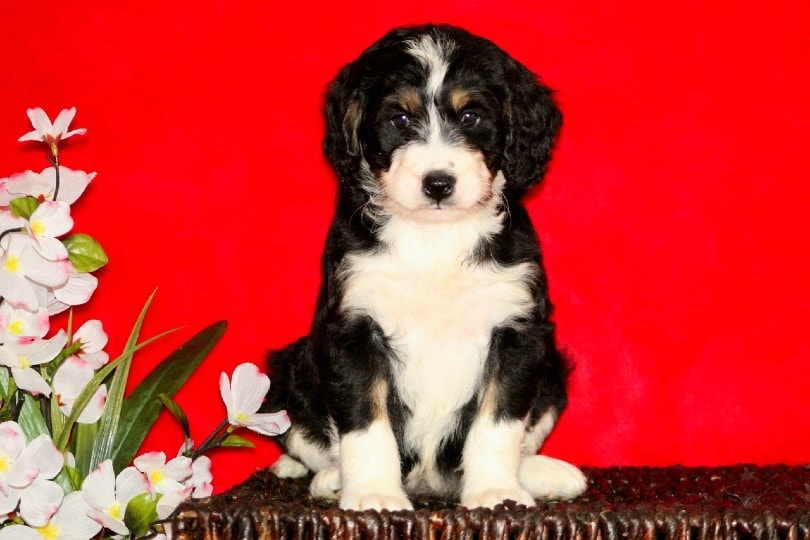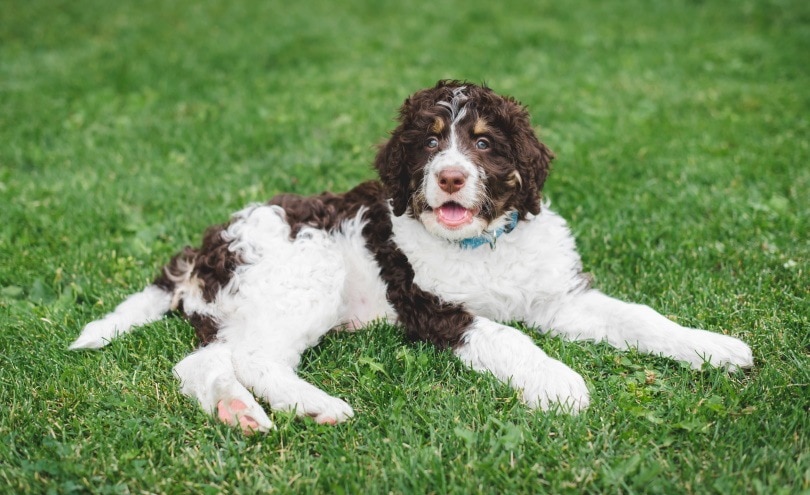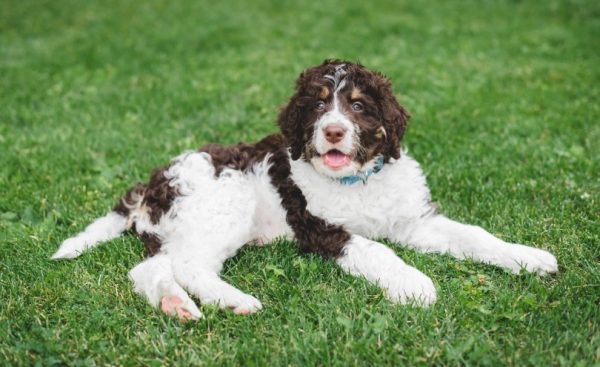Click Below to Skip Ahead
The Bernedoodle is a cross between the intelligent Poodle and the gentle giant, the Bernese Mountain Dog. Owners say that the hybrid adopts the best features of both parent breeds and that this results in an intelligent and easily trainable dog that loves its family and is especially good with children. They have also adopted the Poodle’s low-shedding coat, leading to them being described as hypoallergenic.
Breed Overview
Height:
23 – 30 inches
Weight:
70 – 90 pounds
Lifespan:
12 – 16 years
Colors:
Black, brown, white, gray
Suitable for:
Loving families looking for a companion for all family members
Temperament:
Loving, loyal, affectionate, great with children
The Bernedoodle is a cross between the intelligent Poodle and the gentle giant, the Bernese Mountain Dog. Owners say that the hybrid adopts the best features of both parent breeds and that this results in an intelligent and easily trainable dog that loves its family and is especially good with children. They have also adopted the Poodle’s low-shedding coat, leading to them being described as hypoallergenic.
The breed is playful and is especially popular for its willingness to play with children. They do well with children and family members of all ages but especially if they were introduced when the children and the dogs were young.
Although the Bernedoodle is known as a clever dog that has the propensity to be easily trained, it does require a consistent and firm handler when young. The breed also needs early socialization. They are a large breed, and like all puppies, they do jump in a bid to try and be closer to people. Socialization and training teach them that this is not always acceptable behavior.
Bernedoodle Puppies

The Bernedoodle is a hybrid breed, but while this designer breed is not purebred, it has gained in popularity. It is intelligent, friendly, good with children, and playful, so is popular with all families and buyers. Once you find a breeder, ask about the puppy’s parents, the adoption process, and the puppy itself. Ensure that the parents underwent the necessary screening. Screening is conducted for conditions like joint dysplasia and while a clear result for the parents does not guarantee that the puppy will be problem-free, it does improve the likelihood of a healthy dog.
Ask to meet the puppy, and meet it at least once. Use this opportunity to meet one or both parent dogs. See how the puppy interacts with you and other people, and determine the character of the parent dog. Again, there is no guarantee that a young puppy will inherit the same attributes as its mum, but it will take early social cues from its parent, so a well-behaved mom is a precursor to a well-behaved puppy.
Although this is a designer breed, and the puppies can be expensive, you may still find them in shelters. Take the same precautions when adopting as when buying.

Temperament & Intelligence of the Bernedoodle
The Bernedoodle is said to adopt the positive traits of both breeds and owners claim that it is friendly and makes a great family dog.
The individual dog’s character is more important than its breed when it comes to determining what the dog will be like. However, breeding and genetics can point in the most likely direction.
Are These Dogs Good for Families? 👪
The Bernedoodle is prized as a family dog. It might be large, but it is one of those giant breeds that knows how to behave well around children, especially small children. Its size may be beneficial because it can withstand rough play from its owners, which is especially important when young hands grab hold of ears and clumps of hair.
Although the breed is gentle, it does require some early training. Puppies jump up and when they weigh around 80 pounds and have claws, this can lead to injury. You need to be consistent and fair when training, but it shouldn’t take long for your Bernedoodle to get to grips with what you want because they are intelligent and eager to please.
Does This Breed Get Along with Other Pets? 🐶 😽
It is typical for the Bernedoodle to get along with other dogs. In fact, yours might benefit from having a playmate that will keep them company when you’re not around. As always, you have a better chance of a happy relationship between the two if you introduce them when they are young.
Similarly, if you introduce your Bernedoodle to your cat when they are both young, they should get along well.
You should never leave a dog alone with smaller animals. Although the Bernedoodle is not really known for having an active prey drive, Poodles were bred to chase and catch birds so they may be distracted by fast and small animals.

Things to Know When Owning a Bernedoodle:
The breed is known to be good for families, great with kids, and will usually get along with dogs and other animals. It is intelligent, loving, and quick to learn. But it is a large breed, can be a bit clumsy at times, and does require quite a lot of exercise to be happy. As great as the Bernedoodle breed is, it is not the ideal choice for all potential owners. Read on to see what you need to know when thinking about taking on one of this breed.
Food & Diet Requirements 🦴
Bernedoodles benefit from having two or even three regular meals a day. This helps you maintain and monitor the amount of food they receive and it can help prevent the problem of excessive eating that comes from a grazing diet.
The Bernedoodle is prone to obesity, so you should measure the amount of food you give, and ensure that this meets the manufacturer requirements or, better still, the requirements of your bet.
Generally, feed between 2-3 cups of good quality dry kibble per day. Follow the instructions for wet food, and, if you intend to feed a combination diet consisting of wet and dry food, cut the amount of both down accordingly. If you are feeding half and half, feed half the recommended amount of dry food and half the wet food.
If you feed treats, take these out of your Bernedoodle’s daily allowance, otherwise, you will be overfeeding.
Exercise 🐕
The breed usually requires at least one walk a day, which should be of moderate intensity, but if you are willing and happy to provide more, then your Bernedoodle will keep up. The breed’s intelligence means that it will perform well in canine sports, and if the dog takes after its Bernese Mountain Dog parent, it will be strong and very capable in events like carting and cart pulling.
Bernedoodles mixed with Standard Poodles will do better living in a house with a yard, where they can burn off energy and spend time playing with family members. Smaller examples of the breed can adapt well to life in an apartment as long as they do get that daily walk.
Training 🎾
The breed is highly intelligent, like its Poodle parent. This works as a benefit because it means that your puppy will quickly pick up new commands if it wants to. It also means that, especially as a young puppy, your Bernedoodle may believe that it knows best and will try to outsmart you.
Offer consistent training, be fair, and do not be physical when it comes to training techniques. Use treats. Offer plenty of praise to your loving puppy when it picks up a new and desired response.
Grooming ✂️
A Bernedoodle will usually share the same type of coat as the Poodle because this is one attribute that breeders want to carry from generation to generation. This means that it does not shed and continuously grows. Despite this, your Bern doesn’t require too much attention, but it will require brushing once or twice a week and should only be bathed once or twice a year to protect and retain the natural oils in the coat. You should have your dog professionally groomed and cut every 3 months.
Starting when your Bernedoodle is a puppy, trim their claws every two or three months, and brush their teeth at least twice a week and ideally every day. Starting young will make it easier on both of you.
Health and Conditions 🏥
A generally healthy breed, you will need to look for symptoms and signs of the following conditions and have your dog checked out by a vet if it does develop any illness.
- Skin issues
- Elbow dysplasia
- Hip dysplasia
 Male vs Female
Male vs Female
Generally, the male of the breed will grow a little bigger and taller than the female and may be considered a bit clumsier and more playful than the female. However, the differences are minimal, and other owners report the opposite. Both genders are considered excellent and loving, loyal pets.
3 Little-Known Facts About the Bernedoodle
1. They Are Described As Hypoallergenic
Poodles are described as being hypoallergenic. Although no dog can be truly hypoallergenic because they all secrete at least some of the protein that causes allergic reactions, the Poodle has a single layer coat that sheds minimally. Most dogs continuously shed their fur as it grows, but the Poodle has hair, rather than fur, and it continues to grow and grow. This does mean that it requires regular trimming and grooming, but it also minimizes the amount of stray fur. The fact that the Poodle only has a single layer of coat means that there is less fur, too.
It also produces very little dander and the Poodle is not a heavy salivatory. Dander, saliva, and urine are the main causes of allergic reactions to dogs, so as long as you can avoid your dog’s urine, you should not suffer from reactions.
The Bernedoodle gets several traits from its Poodle parent, including its hypoallergenic nature. It does not shed heavily, produces minimal dander, and is not usually prone to excess salivation.
2. The Bernese Mountain Dog Is a Swiss Mountain Dog
The Bernese Mountain Dog is one of four Swiss mountain dog breeds, along with the Appenzeller, Entlebucher, and the Greater Swiss Mountain Dog. To survive in the cold and difficult conditions of the Swiss Alps, the Bernese has long hair and strong, muscular legs. These characteristics were also developed because they were beneficial for herding and guarding.
The Bernese Mountain Dog was a multipurpose livestock dog, so it would have herded livestock when required, and then kept guard over the animals to protect them against predators. Over time, their strength and size saw them being used as delivery dogs and cart dogs and they are still very strong dogs indeed.
3. The Poodle Is Actually German
The Poodle is the national dog of France, so it is perhaps a little surprising that the breed actually originates from Germany. In fact, the name Poodle comes from the German word pudel, which means to paddle in the water. This alludes to the fact that the Poodle was first bred as a water retriever: a hunting dog that would gather their handlers’ kill from the waters of rivers and lakes.
They are still used for this purpose today, although they are just as likely to be seen in a show ring or on a couch. They are also used as therapy dogs, guide dogs, and assistance dogs.
Final Thoughts
A combination of the Poodle and the Bernese Mountain Dog, the Bernedoodle is an intelligent, loving, and loyal dog. It makes a great family pet, no matter the age or size of your children, and is generally easy to care for, although its low-shedding cost does require some weekly maintenance to prevent it from getting matted and knotted.
Train and socialize from a young age, ensure that you don’t overfeed your Bernedoodle, and be prepared to go out for a decent walk every day, and you will have a loving and loyal pet that enjoys cuddles and is thrilled to spend time with you.
See also:
- Golden Mountain Dog (Golden Retriever & Bernese Mountain Dog Mix)
- Labradoodle Dog Breed vs. Bernedoodle Dog Breed: The Key Differences (With Pictures)
Featured Image Credit: Cavan-Images, Shutterstock










